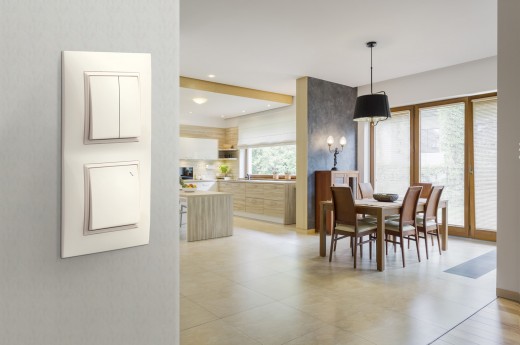Electric switches

What are electric switches actually? Putting it simply, these are devices, or rather electric apparatus, used to switch electrical current in an electrical circuit on/off. Informally referred to as light switches, in addition to sockets, they are the most common electrical equipment applied when designing an electrical system. Furthermore, this is the type of a device you all want to affect as its aesthetic values, location and other functions have a direct influence on your everyday life comfort.
How to arrange light switches in a building?
Optimal arrangement of switches in a hours is very important. It is not just a matter of convenience, but it is about safety of residents in the first place.
Therefore, light and other switches in flats and houses are mounted usually at the room entrance. If a door is installed in the room, a switch should be located on the side of the knob, i.e. on the side opposite to the door opening direction. It is the most common solution applied.
In a bathroom, restroom and rooms without windows, light switches are mounted outside. It is particularly important for all staircase or basement entrances.
When designing a system, it is important to consider whether a switch is positioned at the right height. For people on wheelchairs and children, a switch should be easily accessible as for other household members.
What is more, wherever it is possible for water steam or moisture to occur (bathrooms, kitchens, ground floors, garages), electric switches should feature an extended degree of protection. Thus, IP44 or IP45 switches will be suitable for this type of rooms.
On commercial and office premises, switch arrangement principles are similar. In this case, however, depending on the surface area of an office, shop or warehouse, other solutions apply. In many such rooms there are one or two main panels responsible for switching lights on/off, e.g. in the morning or after work. Besides, individual switches are arranged also in specific sections of a room to adjust light intensity to the needs of users at a given moment, e.g. in office conference rooms or shop changing rooms.
How many switches do you need?
The number of switches is of course determined by the room and its function but you should also remember to adjust it to the number of circuits. Switches may be intended for operation with one or several electrical circuits.
In some rooms, you will have to install more than just one lighting point. If this is the case, you should install the points on separate circuits so that you don’t have to turn the light on and off in all of them, and so each circuit will require an independent switch.
Light switch is an element of modern interior design
When choosing the correct switch, appearance is of great importance as well. Today, the market is full of various electrical switches suitable for different interior types, from traditional to modern ones. OSPEL’s Karo range is ripe with pastel colours of extraordinary beauty, while in the Sonata or Impresja range you can find glass, aluminium, or even wooden frames for electrical switches. As you can emphasise the nature of a residential or commercial room with correct aesthetics of the switches, it is beneficial to take your time when choosing which one to buy.


